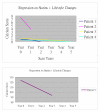Outcome of coronary plaque burden: a 10-year follow-up of aggressive medical management
- PMID: 20226020
- PMCID: PMC2850323
- DOI: 10.1186/1476-7120-8-5
Outcome of coronary plaque burden: a 10-year follow-up of aggressive medical management
Abstract
Background: The effect of aggressive medical therapy on quantitative coronary plaque burden is not generally known, especially in ethnic Chinese.
Aims: We reasoned that Cardiac CT could conveniently quantify early coronary atherosclerosis in our patient population, and hypothesized that serial observation could differentiate the efficacy of aggressive medical therapy regarding progression and regression of the atherosclerotic process, as well as evaluating the additional impact of life-style modification and the relative effects of the application of statin therapy.
Methods: We employed a standardized Cardiac CT protocol to serially scan 113 westernized Hong Kong Chinese individuals (64 men and 49 women) with Chest Pain and positive coronary risk factors. In all cases included for this serial investigation, subsequent evaluation showed no significantly-obstructive coronary disease by functional studies and angiography. After stringent risk factor modification, including aggressive statin therapy to achieve LDL-cholesterol lowering conforming to N.C.E.P. ATP III guidelines, serial CT scans were performed 1-12 years apart for changes in coronary artery calcification (CAC), using the Agatston Score (AS) for quantification.
Results: At baseline, the mean AS was 1413.6 for males (mean age 54.4 years) and 2293.3 for females (mean age 62.4 years). The average increase of AS in the entire study population was 24% per year, contrasting with 16.4% per year on strict risk factor modification plus statin therapy, as opposed to 33.2% per year for historical control patients (p < 0.001). Additionally, 20.4% of the 113 patients demonstrated decreasing calcium scores. Medical therapy also yielded a remarkably low adverse event rate during the follow-up period --- 2 deaths, 2 strokes and only 1 case requiring PCI.
Conclusions: This study revealed that aggressive medical therapy can positively influence coronary plaque aiding in serial regression of calcium scores.
Figures



Similar articles
-
Effect of HMG-CoA reductase inhibitors on coronary artery disease as assessed by electron-beam computed tomography.N Engl J Med. 1998 Dec 31;339(27):1972-8. doi: 10.1056/NEJM199812313392703. N Engl J Med. 1998. PMID: 9869668
-
Effect of statin treatment on coronary plaque progression - a serial coronary CT angiography study.Atherosclerosis. 2013 Dec;231(2):198-204. doi: 10.1016/j.atherosclerosis.2013.08.019. Epub 2013 Aug 29. Atherosclerosis. 2013. PMID: 24267226
-
[Effects of statin intervention on mild coronary plaque progression assessed by serial coronary CT angiography].Zhonghua Xin Xue Guan Bing Za Zhi. 2016 Jun 24;44(6):508-12. doi: 10.3760/cma.j.issn.0253-3758.2016.06.010. Zhonghua Xin Xue Guan Bing Za Zhi. 2016. PMID: 27346264 Chinese.
-
The Role of a Coronary Artery Calcium Scan in Type 1 Diabetes.Diabetes Technol Ther. 2016 Sep;18(9):594-603. doi: 10.1089/dia.2016.0110. Epub 2016 Sep 1. Diabetes Technol Ther. 2016. PMID: 27585206 Free PMC article. Review.
-
Monitoring the effectiveness of preventive interventions using progression of coronary calcification with electron beam tomography.J Cardiovasc Risk. 2000 Apr;7(2):107-12. doi: 10.1177/204748730000700204. J Cardiovasc Risk. 2000. PMID: 10879413 Review.
Cited by
-
Comparison of coronary arterial lumen dimensions on angiography and plaque characteristics on optical coherence tomography images and their changes induced by statin.BMC Med Imaging. 2016 Nov 22;16(1):63. doi: 10.1186/s12880-016-0166-4. BMC Med Imaging. 2016. PMID: 27871242 Free PMC article. Clinical Trial.
-
Effects of long-term statin-treatment on coronary atherosclerosis in patients with inflammatory joint diseases.PLoS One. 2019 Dec 12;14(12):e0226479. doi: 10.1371/journal.pone.0226479. eCollection 2019. PLoS One. 2019. PMID: 31830762 Free PMC article.
-
Coronary CT angiography in managing atherosclerosis.Int J Mol Sci. 2015 Feb 9;16(2):3740-56. doi: 10.3390/ijms16023740. Int J Mol Sci. 2015. PMID: 25671814 Free PMC article. Review.
-
Progression of coronary artery calcification at the crossroads: sign of progression or stabilization of coronary atherosclerosis?Cardiovasc Diagn Ther. 2016 Jun;6(3):250-8. doi: 10.21037/cdt.2016.03.03. Cardiovasc Diagn Ther. 2016. PMID: 27280088 Free PMC article. Review.
References
-
- Woo KS, Robinson JT, Chook P, Adams MR, Yip G, Mai ZJ, Lam CWK, Sorenson KE, Deanfield JE, Celermajer DS. Differences in the effect of cigarette smoking on endothelial function in Chinese and white adults. Ann Intern Med. 1997;127 372375. - PubMed
-
- Chen LC, Ding PY, Chen JW, Wu MH, Liu JC, Lan GY, Chem MS, Chang CY, Chang MS. Coronary artery calcium determined by electron beam computed tomography for predicting angiographic coronary artery disease in moderate- to high-risk Chinese patients. Cardiology. 2001;95(4):183–9. doi: 10.1159/000047370. - DOI - PubMed
-
- Tso DK, Moe G. Cardiovascular disease in Chinese Canadians: a case-mix study from an urban tertiary care cardiology clinic. Can J Cardiol. 2002;18(8):861–9. - PubMed
MeSH terms
Substances
LinkOut - more resources
Full Text Sources
Medical
Research Materials
Miscellaneous

